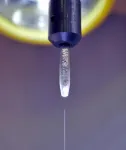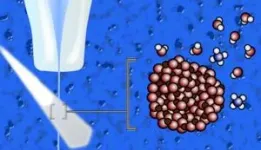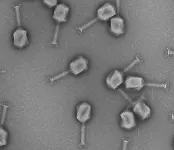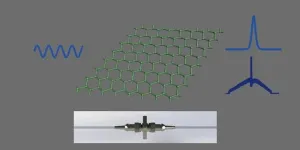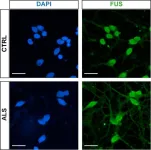(Press-News.org) Green hydrogen can be produced directly in a photoelectrochemical cell, splitting water with solar energy. However, this requires the development of super-efficient photoelectrodes that need to combine many talents at the same time: They must be excellent at converting sunlight into electricity, remain stable in acidic or basic water, act as catalysts to promote the splitting of water into hydrogen and oxygen, and be cheap, abundant and non-toxic. The large material class of metal oxides comes into question. However, it is difficult to find out what really happens at the interfaces between the solid metal oxide electrodes and the aqueous electrolyte. This is because standard X-ray analysis does not work to investigate processes on samples in liquid environments. One of the few suitable methods are experiments with a liquid jet: an extremely fine jet of liquid in which nanoparticles of metal oxide are suspended. This jet shoots through the X-ray light of BESSY II, and the interference of the evaporated molecules with the measurement data is negligible (more in the foreword to the special issue).
Dr. Robert Seidel is an expert on this liquid jet method, which is the subject of a special issue of Accounts of Chemical Research. He was invited to be the guest-editor of the issue and to report also on new experiments at BESSY II that he conducted with Dr. Hebatallah Ali and Dr. Bernd Winter from the Fritz Haber Institute.
They investigated two important model systems for photoelectrodes: Nanoparticles of iron oxide (hematite, α-Fe2O3, and anatase (titanium oxide or TiO2) in aqueous electrolytes with different pH values. Hematite and anatase in suspension are photocatalytic model systems. They are ideal for studying the solid/electrolyte interface at the molecular level and for exploring the chemical reactions at electrode-electrolyte interfaces.
"We used resonant photoelectron spectroscopy (PES) to identify the characteristic fingerprints of different reactions. This allowed us to reconstruct which reaction products are formed under different conditions, particularly as a function of pH." The key question: How do the water molecules react with or on the nanoparticle surfaces?
In fact, how acidic or how basic an electrolyte is makes a big difference, Seidel noted. "At low pH, the water molecules on the surface of hematite tend to split. This is not the case with anatase, where water molecules are adsorbed on the surface of the TiO2 nanoparticles," says Seidel. A basic pH value is required for water molecules to break down on the anatase nanoparticles. "Such insights into surface interactions with water molecules are only possible with this liquid-jet method," says Seidel.
The spectra also revealed ultra-fast electron transitions between the metal oxide and the (split) water molecules on the surface. The results provide insights into the first steps of water dissociation and help to clarify the mechanisms of light-induced water splitting on metal oxide surfaces.
The special issue ‘Applications of Liquid Microjets in Chemistry’:
“Pour a glass of water, and bring it right up to your nose, one centimeter away. What don’t you see? About 3 million molecules intervene along a line between the tip of your nose and the surface of the water. Imagine an X-ray photon or charged or neutral particle trying to reach or escape the surface but first colliding with some of these interloping molecules in ways that scramble information about their interactions with interfacial and deeper water molecules.”
What is so vividly described in the foreword to this special issue has long been a major problem. It was not until 1988 that the liquid jet method, introduced by Manfred Faubel, Stephan Schlemmer and Jan Peter Toennies, made it possible to study water surfaces without these disturbances. The microjet is a fast-flowing stream of liquid so narrow that it produces only an extremely dilute vapour cloud. Photons and particles can reach and leave the surface of the jet without colliding with the vapour molecules. A special issue of the journal Accounts of Chemical Research now presents exciting new results using this method. HZB researcher Dr Robert Seidel was invited to be the guest editor.
END
BESSY II: Surface analysis of catalyst particles in aqueous solutions
In a special issue on the liquid jet method, a team reports on reactions of water molecules on the surfaces of metal oxide particles. The results are relevant for the development of efficient photoelectrodes for the production of green hydrogen.
2023-07-21
ELSE PRESS RELEASES FROM THIS DATE:
Study: How mother and infant sleep patterns interact during the first two years of life
2023-07-21
URBANA, Ill. — New mothers can expect sleep deprivation in the first few years of baby’s life. But too little sleep can take a toll on the health of both mother and child. A new study from the University of Illinois Urbana-Champaign looks at maternal and infant sleep patterns, identifying predictors and providing recommendations for instilling healthy habits.
“The first two years is a really critical period where a lot of development is going on, and sleep is important for health. We wanted to look at the association of mother and infant sleep and whether it changes over time,” said Tianying ...
Contribution of cultural heritage values to steppe conservation on ancient burial mounds of Eurasia
2023-07-21
During our history, ancient civilisations have considerably shaped the global ecosystems through a coevolution of landscape and local populations. In some cases, the legacy of the disappeared civilizations is still visible in the form of buildings and other monuments such as the Stonehenge, the buildings of the Roman and Hellenic Empires, and ancient burial places and fortresses built by several cultures. These monuments are invaluable parts of our history and cultural heritage. Although it is often not in the spotlight, they can also hold a considerable biodiversity conservation potential.
In the vast steppes of Eurasia (and probably ...
NIH grant to facilitate high-speed bioprinting of bones, tracheas, organs
2023-07-21
UNIVERSITY PARK, Pa. — Developing technology to quickly and efficiently bioprint human tissues at scale is the goal of a new project led by Penn State researchers. When fully developed, the technology will be the first to enable the fabrication of scalable, native tissues such as bones, tracheas and organs.
The National Institute of Biomedical Imaging and Engineering at the National Institute of Health has awarded over $2 million in support of the project, led by Ibrahim T. Ozbolat, professor of engineering science and mechanics, biomedical engineering, and neurosurgery at Penn State.
“This will be a platform technology, which can be used for multiple purposes,” ...
Penn State researchers examine how environmental chemicals affect gut microbiome
2023-07-21
UNIVERSITY PARK, Pa. — Worldwide, high rates of obesity and other inflammatory conditions are associated with increased risk for cancer, cardiovascular disease and type 2 diabetes. Investigating how environmental chemical exposure impacts the gut microbiome to exacerbate these conditions is the goal of a new $7 million grant awarded to Andrew Patterson, professor of molecular toxicology and the John T. and Paige S. Smith Professor in the College of Agricultural Sciences.
The National Institute of Environmental Health Sciences, part of the National ...
Treating bladder infections with viruses
2023-07-21
About one in two women are affected by cystitis during her lifetime, and many suffer from recurrent urinary tract infections. Bladder infections are not only painful and potentially dangerous, but they also pose a significant dilemma for physicians. With antibiotic resistance becoming widespread in urinary tract infections and continually increasing, physicians are often forced to blindly prescribe antibiotics without knowing their effectiveness against the pathogen causing the infection. This is because it takes several days to identify a specific ...
Two types of ultrafast mode-locking operations generation from an Er-doped fiber laser based on germanene nanosheets
2023-07-21
Saturable absorbers as passive modulators in passively mode-locked fiber lasers play a crucial role in the generation of ultrashort pulses. Germanene, a graphene-like two-dimensional material with fast carrier relaxation time and large nonlinear absorption coefficient comparable to that of graphene, is a saturable absorber material with very fast response.
Researchers led by Prof. Wei Xia at University of Jinan (UJN), are interested in modulation switches in fiber lasers, and two-dimensional material saturable absorbers have been a hot research topic in recent years. Two-dimensional materials make up for the disadvantages of ...
Trends in the prevalence of hepatitis C infection during pregnancy and maternal-infant outcomeTrends in the prevalence of hepatitis C infection during pregnancy and maternal-infant outcomes
2023-07-21
About The Study: This study of more than 70 million births or spontaneous abortions showed the prevalence of hepatitis C (HCV)-positive pregnancies in the U.S. increased 16-fold between 1998 and 2018. Maternal HCV infection was associated with increased odds of preterm labor, poor fetal growth, or fetal distress. These data may support recent recommendations for universal HCV screening with each pregnancy.
Authors: Po-Hung Chen, M.D., Ph.D., of the Johns Hopkins University School of Medicine in Baltimore, ...
Association between cervical cancer screening guidelines and preterm delivery
2023-07-21
About The Study: The findings of this study of births to females ages 18 to 24 suggest that additional recommended cervical cancer screenings before birth were associated with an increased risk of preterm delivery. Cervical cancer screening guidelines should consider the downstream implications for preterm delivery risk when weighing the population-level costs of screenings against the benefits of reduced cervical cancer mortality.
Authors: Rebecca Bromley-Dulfano, M.S., of Harvard University Medical School in Cambridge, Massachusetts, is the corresponding author.
To ...
Research reveals the scale of disorder underpinning Motor Neurone Disease
2023-07-21
Francis Crick Institute press release
Under strict embargo: 16:00hrs BST 21 July 2023
Peer reviewed
Experimental study
Cells
Research reveals the scale of disorder underpinning Motor Neurone Disease
Researchers at the Francis Crick Institute and UCL have shown that hundreds of proteins and mRNA molecules are found in the wrong place in nerve cells affected by Motor Neuron Disease (MND), also known as Amyotrophic Lateral Sclerosis (ALS).
ALS is a rapidly progressing and devastating condition that causes paralysis by affecting ...
Scripps Research scientists develop AI-based tracking and early-warning system for viral pandemics
2023-07-21
LA JOLLA, CA — Scripps Research scientists have developed a machine-learning system—a type of artificial intelligence (AI) application—that can track the detailed evolution of epidemic viruses and predict the emergence of viral variants with important new properties.
In a paper in Cell Patterns on July 21, 2023, the scientists demonstrated the system by using data on recorded SARS-CoV-2 variants and COVID-19 mortality rates. They showed that the system could have predicted the emergence of new SARS-CoV-2 “variants of concern” (VOCs) ahead of their official designations by the World Health Organization (WHO). Their ...
LAST 30 PRESS RELEASES:
Heart-brain connection: international study reveals the role of the vagus nerve in keeping the heart young
Researchers identify Rb1 as a predictive biomarker for a new therapeutic strategy in some breast cancers
Survey reveals ethical gaps slowing AI adoption in pediatric surgery
Stimulant ADHD medications work differently than thought
AI overestimates how smart people are, according to HSE economists
HSE researchers create genome-wide map of quadruplexes
Scientists boost cell "powerhouses" to burn more calories
Automatic label checking: The missing step in making reliable medical AI
Low daily alcohol intake linked to 50% heightened mouth cancer risk in India
American Meteorological Society announces Rick Spinrad as 2026 President-Elect
Biomass-based carbon capture spotlighted in newly released global climate webinar recording
Illuminating invisible nano pollutants: advanced bioimaging tracks the full journey of emerging nanoscale contaminants in living systems
How does age affect recovery from spinal cord injury?
Novel AI tool offers prognosis for patients with head and neck cancer
Fathers’ microplastic exposure tied to their children’s metabolic problems
Research validates laboratory model for studying high-grade serous ovarian cancer
SIR 2026 delivers transformative breakthroughs in minimally invasive medicine to improve patient care
Stem Cell Reports most downloaded papers of 2025 highlight the breadth and impact of stem cell research
Oxford-led study estimates NHS spends around 3% of its primary and secondary care budget on the health impacts of heat and cold in England
A researcher’s long quest leads to a smart composite breakthrough
Urban wild bees act as “microbial sensors” of city health.
New study finds where you live affects recovery after a hip fracture
Forecasting the impact of fully automated vehicle adoption on US road traffic injuries
Alcohol-related hospitalizations from 2016 to 2022
Semaglutide and hospitalizations in patients with obesity and established cardiovascular disease
Researchers ‘listen in’ to embryo-mother interactions during implantation using a culture system replicating the womb lining
How changing your diet could help save the world
How to make AI truly scalable and reliable for real-time traffic assignment?
Beyond fragmented markets: A new framework for efficient and stable ride-pooling
Can shape priors make road perception more reliable for autonomous driving?
[Press-News.org] BESSY II: Surface analysis of catalyst particles in aqueous solutionsIn a special issue on the liquid jet method, a team reports on reactions of water molecules on the surfaces of metal oxide particles. The results are relevant for the development of efficient photoelectrodes for the production of green hydrogen.
